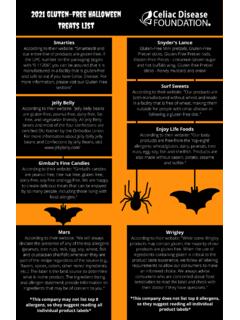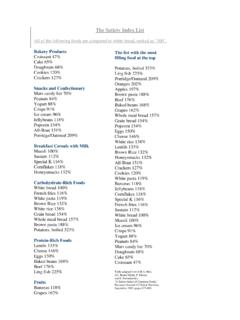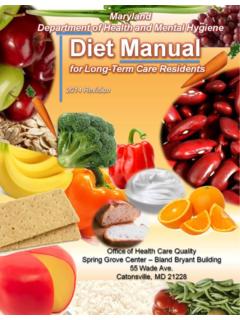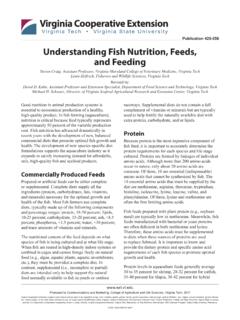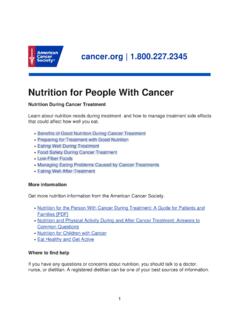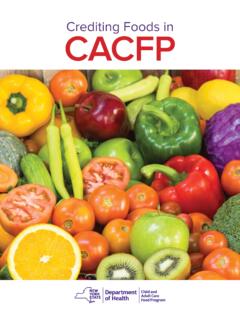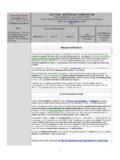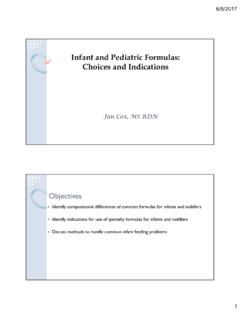Transcription of Gluten-Free Diet Guide for Celiac Disease & Non-Celiac ...
1 The Quick Start Guide is designed to provide a basic understanding of the Gluten-Free diet. Not all areas of the diet are as clear-cut as portrayed by this Guide . This is intended to be used as a basic reference tool for people newly diagnosed with Celiac Disease , dermatitis herpetiformis and non- Celiac gluten sensitivity. For more detailed information consult with a dietitian who is knowledgeable in the Gluten-Free diet and go to the websites listed on the back of this brochure. The term gluten -related disorders refers to all conditions resulting from the ingestion of gluten , including Celiac Disease , dermatitis herpetiformis and non- Celiac gluten sensitivity. Celiac Disease is a chronic autoimmune Disease affecting children and adults. Dermatitis herpetiformis is the skin manifestation of Celiac Disease . When individuals with Celiac Disease and dermatitis herpetiformis eat foods that contain gluten , an immune response is triggered that causes damage to the villi in the lining of the small intestine.
2 As a result, food and its nutrients are not properly absorbed. Even small amounts of gluten in foods can affect those with Celiac Disease and dermatitis herpetiformis and cause health problems. Damage can occur to the small intestine even if there are no symptoms gluten sensitivity is an immune response to gluten with many symptoms. The exact cause is unknown. Although it is not believed that non- Celiac gluten sensitivity involves damage to the small intestine, gluten must still be removed from the diet. gluten is the generic name for certain types of proteins found in the common cereal grains wheat, barley, rye and their derivatives. Spelt, semolina, durum and triticale are examples of some other gluten -containing grain products found in food Naturally Gluten-Free Grains and Flours, including rice, cassava, corn (maize), soy, potato, tapioca, beans, sorghum, quinoa, millet, buckwheat, arrowroot, amaranth, teff, flax, chia, yucca, and nut indicates that pure, uncontaminated oats consumed in moderation (up to cup dry rolled oats daily) are tolerated by most people with Celiac Disease .
3 Look for uncontaminated oats that are specifically labeled your physician or dietitian before including gluten -Quick Start Gluten-Free Diet Guide for Celiac Disease & Non- Celiac gluten Sensitivityfree oats in your diet and for regular follow-ups to monitor your response to the Gluten-Free diet. The following grains and ingredients derived from these gluten -containing grains must be removed from the diet: Wheat Includes varieties such as: durum, emmer, spelt, farina, farro, KAMUT khorasan wheat and einkorn. Barley Rye Triticale, a cross-breed of wheat and ryeLabeling RequirementsThe key to successfully following the Gluten-Free diet is to become a careful and thorough reader of labels on packaged foods. This includes both ingredient labels and Gluten-Free claims. Manufacturers can change ingredients at any time so you should read labels every time you purchase foods.
4 The food Allergen Labeling and Consumer Protection Act (FALCPA) applies to the majority of packaged food products, those regulated by the food and Drug Administration (FDA). The law requires that packaged food products which include an ingredient that contains protein from any of the top eight allergens (milk, eggs, peanuts, tree nuts, fish, soy, wheat and Crustacean shellfish) be labeled in one of two ways: the allergen must be named in either the ingredient list or a separate Contains statement immediately following or next to the ingredient also required a federal standard to be set defining the term Gluten-Free and rules for using the term on product labels. The FDA announced on August 2, 2013 that if a product bears the label Gluten-Free , the food must contain less than 20 ppm gluten , as well as meet other criteria.
5 * The rule also applies to products labeled no gluten , free of gluten , and without gluten . The labeling of food products as Gluten-Free is a voluntary action for manufacturers. The use of a Gluten-Free label does not replace or eliminate the need to comply with the mandatory allergen labeling which requires wheat to be listed as described above. Note that a product whose label indicates the presence of wheat may be Gluten-Free if the wheat-containing ingredient ( wheat starch) has been processed to remove gluten and results in a gluten content of less than 20 ppm. In such situations the labeling must indicate that The wheat has been processed to allow this food to meet FDA requirements for Gluten-Free foods. The regulation also applies to dietary supplements, but not to over-the-counter or prescription medications.
6 Manufacturers choosing to label products Gluten-Free will be required to comply with this regulation by August 5, 2014. Consumers need to be aware that the use of a Gluten-Free label is optional, and non-labeled products may still be Gluten-Free . Reading the label to check ingredients remains an essential part of successfully managing the Gluten-Free diet. * For more information: Search Questions and Answers: Gluten-Free food Labeling Final Rule Label ReadingIf a product bears a Gluten-Free claim after August 5, 2014, it is considered to have met the FDA regulations of less than 20 ppm gluten and should be safe to manufacturers have until that date to comply with the Gluten-Free food labeling rule, it is essential to read the ingredient label in its entirety, whether or not the product bears a Gluten-Free claim. Look for the following ingredients and these words in the ingredient list or Contains statement: Wheat, Barley, Rye, Malt, Brewer s yeast, Oats (unless specifically labeled Gluten-Free ).
7 Are all food products covered under the FALCPA labeling rules? No. The labeling requirements in FALCPA only apply to food products regulated by the FDA. Those products regulated by the Department of Agriculture (USDA) are not required to comply with FALCPA. The USDA regulates egg products, poultry products, meat products, and mixed food products that generally contain more than three percent raw meat or two percent or more cooked meat or poultry ( soups, chilis, frozen entrees).Even though USDA products are not required to comply with FALCPA, it s estimated that 80 to 90% of these products voluntarily comply. If there is any doubt about whether a USDA-regulated product is complying with FALCPA labeling, the following ingredients may be derived from wheat and need to be avoided or investigated: Starch, food starch, modified food starch and dextrin.
8 It is important to note that in USDA-regulated products the single word starch can mean either corn starch or wheat starch. If you contact a food manufacturer to verify the source of an ingredient, specify the ingredients and the lot number of the food in question. State your needs clearly - be patient, persistent and polite. When unable to verify ingredients for a food item or if the ingredient list is unavailable DO NOT EAT IT. Adopting a strict Gluten-Free diet is the only known treatment for those with gluten -related disorders. Distilled alcoholic beverages, distilled vinegars, and wine may be safely included in the Gluten-Free diet. Most beers, ales, lagers, malted beverages, and other fermented beverages are made from gluten -containing grains and are NOT Gluten-Free . Beers made from Gluten-Free grains, such as sorghum, are Gluten-Free .
9 Wheat- free May Not be gluten -FreeProducts labeled wheat- free are NOT necessarily Gluten-Free . They may still contain rye, oat or barley-based ingredients that are not in food PreparationIt is imperative when preparing Gluten-Free foods to prevent cross-contamination with foods containing gluten . Contamination can occur if foods are prepared on common surfaces, or with utensils that are not thoroughly cleaned after preparing gluten -containing foods. Using hard to clean equipment for both Gluten-Free and gluten -containing foods is a major source of contamination. Toasters, strainers and flour sifters should not be shared. Deep-fried foods cooked in oil also used to cook breaded products should be avoided. Spreadable condiments in shared containers may also be a source of contamination. When a person dips into a condiment such as mustard, mayonnaise, jam, peanut butter or margarine a second time with the knife used for spreading, the condiment becomes contaminated with crumbs and is not safe for consumption by individuals who cannot tolerate gluten .
10 Consider using condiments in squeeze containers to prevent cross-contamination. Wheat flour can stay airborne for many hours in a bakery or at home and contaminate exposed preparation surfaces and utensils or uncovered Gluten-Free All Adverse Reactions are Due to gluten ConsumptionOther food intolerances, food sensitivities or food allergies, and even the stomach flu are common causes of symptoms similar to those experienced by Gluten-Free consumers who have been exposed to gluten . People newly diagnosed with gluten -related disorders may have trouble digesting certain foods, especially fatty ones, until the small intestine has healed and starts to absorb nutrients normally. It may be helpful to keep a diary of foods eaten. Read labels and listen to your body. Consult a registered dietitian knowledgeable in the Gluten-Free diet and adverse food reactions.
